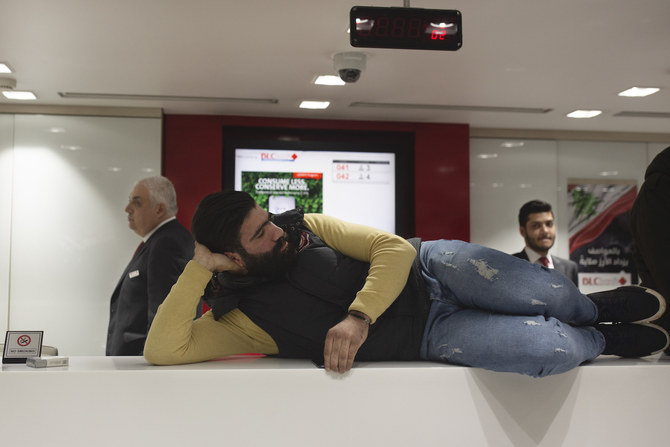Lebanon’s rogue banks called to account

https://arab.news/2a9y9
Protesters who have occupied the streets for weeks demanding political change have characterized the self-professed “technocrat” as a frontman for a kleptocracy that has pillaged the country for three decades.Next to Japan and to Greece, Lebanon is the third most indebted country in the world. However, unlike Japan, where the shortfall is backed by a robust economy, Lebanon’s debt relies on a banking sector that has acted as an accomplice with the corrupt government.
For years the Lebanese banking sector has worked on financing the inefficient government and enriched a few, while killing the productive sector of the country.
Today the sector is driving the country’s bankruptcy through its unlawful practices to save the day for the Lebanese government. People took to the streets demanding the recovery of funds embezzled by corrupt politicians. However, instead of blocking politicians’ accounts, the banks unlawfully blocked the people’s access to money.
Lebanon’s growing debt comes from financing an inefficient and ineffective government that is based on a toxic sectarian division and clientelism.
Sectarianism was institutionalized by the constitution drafted at the end of the civil war. It has created a set-up where different denominations share power and the state resources. Government assets have been used by the “zoama,” or denomination leaders, to further their influence and increase control over their own groups.
In this framework there is no rule of law to manage government revenues and expenses, hence there is no real fiscal policy. People are hired just to vote for a certain leader, while contracts are awarded to enrich another. There are no guidelines for government inflows and outflows. In the meantime, the central bank acts like the government cashier. While the bank is supposed to be controlling the monetary supply, it has taken on the additional role of creating money to finance the corrupt government’s inflated expenses. The central bank relies on the Lebanese banking system, which means that at the end the buck stops with the average Lebanese citizen who puts his savings in a Lebanese bank, in addition to some foreign depositors.
Lebanese prime minister designate, Hassan Diab, seems unable to convince the country’s hard-pressed population that he is the right man for the job.
Dr. Dania Koleilat Khatib
The central bank for years has been issuing treasury bills at high interest rates on the Lebanese pound, increasing demand for the national currency. This has killed the productive sector since the cost of borrowing has become so high. Banks found it highly lucrative to take people’s money and put it in treasury bills and make the spread. They found it much more profitable and easier than doing what banks usually do: Take deposits and extend loans to the private sector. Additionally, when lending to the government, banks avoid facing the business risks associated with lending to the private sector.
After a while the government needed more dollars to finance its international transactions. The central bank began extending debt in dollars. People’s accounts in dollars financed the government debt.
Moreover, for the past three years the central bank has been engaged in financial engineering that allows banks to make outstanding profits at the expense of a growing national debt. The central bank conducts fictitious operations by lending banks amounts, then borrowing from them at a much higher interest rate, giving the banks the spread as profit.These excessive rates were intended to lure depositors into the Lebanese banking system.
For years these practices have led to a growing debt that the economy cannot afford. In recent months, experts have warned of a looming crisis. Regional events have affected remittances to the country, aggravating the situation.
However, the straw that broke the camel’s back was the Assad regime’s liquidity shortage caused by US sanctions. This drove the Syrian regime to ask its allies to withdraw dollars from the Lebanese market and channel them to Syria. However, to mitigate the liquidity crash the Lebanese market is facing, banks are unlawfully holding people’s money. A dollar depositor can withdraw only $300 a week from his account, and the rest can be withdrawn only in Lebanese pounds at the official rate of 1,507.
Using this approach, the bank is unofficially giving people’s accounts a good haircut, forcing them to convert their dollar assets at a rate of 1,507 while the real rate on the exchange market is over 2,000 Lebanese pounds to the dollar. Nevertheless the central bank and its governor claim that the deposits are safe and that there is no cap on withdrawals. At the same time, the central bank is still lending to the government at a 1 percent rate, trying to keep the ailing system together.
However, these “time-buying” practices are very costly and will eventually lead to the collapse of the entire economy. The sad fact is that the price will be paid by the Lebanese people, average citizens who are struggling to make ends meet. Meanwhile, Lebanese politicians are enjoying a good night’s sleep knowing their money is safely hidden in accounts in Switzerland or elsewhere.
- Dr. Dania Koleilat Khatib is a specialist in US-Arab relations with a focus on lobbying. She holds a PhD in politics from the University of Exeter and is an affiliated scholar with the Issam Fares Institute for Public Policy and International Affairs at the American University of Beirut.










































